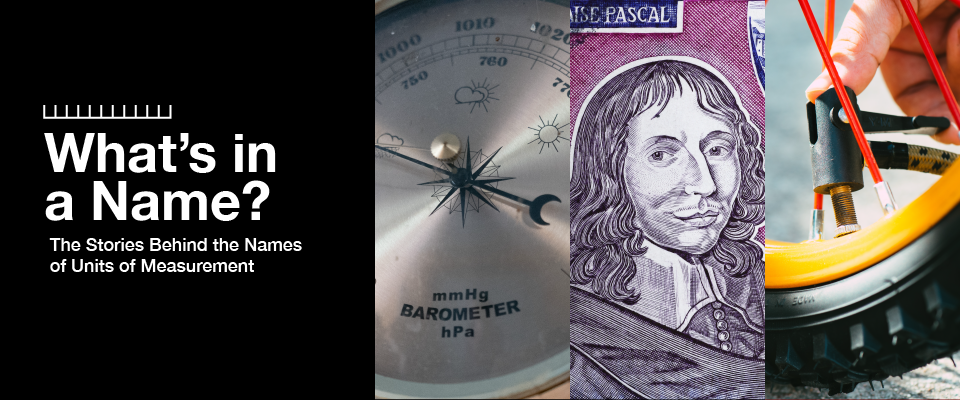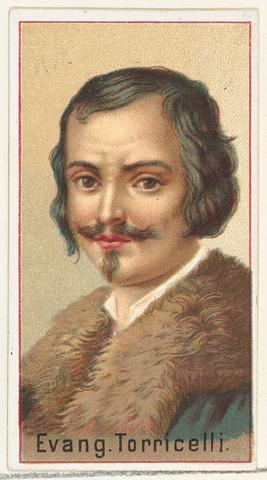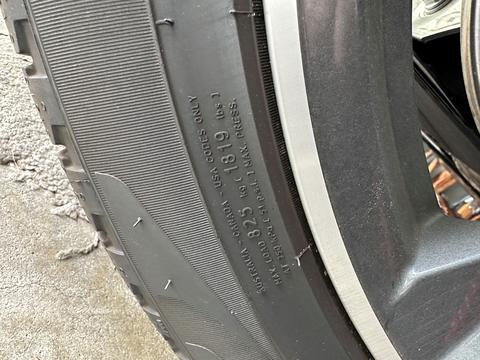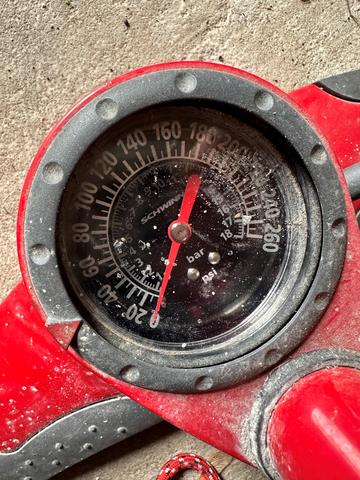Taking Measure
Just a Standard Blog

You know a scientist has made it when they have a unit of measure named after them.
The “pascal” is named for Blaise Pascal — a French mathematician, scientist and philosopher. We commemorate his 400th birthday on June 19 with some interesting notes about his scientific contributions that remain relevant today.
The pascal wasn’t named until long after Pascal’s death, so he probably could’ve never imagined we’d be using his name to measure things hundreds of years later.
Under Pressure
The pascal is a unit of measure for pressure.
Imagine standing in front of a table and pressing down on it with your hand. Your hand would be exerting pascals on the table.
Just like your hand, air itself is pressing down on the table. We measure the pressure of air using an instrument called a barometer. Pascal did not invent the barometer; a highly mustached gentleman called Evangelista Torricelli created it.

This early barometer was created by measuring the height of a column of mercury. Mercury was placed in a bowl. A glass tube with one end open and the top closed was placed in the mercury. The mercury was pushed up the tube (remember the tube is closed on the top) by the pressure of the atmosphere on the bowl of mercury. The height of the mercury in the tube above the surface of mercury in the bowl is the measurement! If there is more pressure, the height of the mercury goes higher up the tube.
The Air Up There
Pascal had a hypothesis that there should be less pressure higher up in the atmosphere because there is less air to press down than lower in the atmosphere. Pascal came up with the idea to measure air pressure going up a mountain (the higher you go in the atmosphere, the lower the pressure) and back down to the ground level.
But Pascal was not healthy enough to travel up the mountain himself. It’s amusing that Pascal kvetched to his brother-in-law for quite a while until he agreed to climb up and down the mountain next to his house to perform the measurement on Pascal’s behalf.
Imagine climbing up and down a mountain carrying a bunch of mercury. Pascal’s brother-in-law had to carefully pour it into a bowl and place four-foot glass tubes in the mercury, measuring the height at different points.
We love an intrepid measurer here at NIST, but this is not something you should try!
The Pascal’s Many Uses
The pascal is also used to measure stress of materials, and commonly, air pressure.
Air pressure gauges for bicycles or car tires usually have markings for air pressure both in metric and nonmetric systems.
For air pressure, the nonmetric measurement unit is the pounds per square inch (psi). Using the metric system, we would measure tire pressure using pascals.
A pascal of pressure is really small, so most practical measures for bikes or tires use kPa (kilopascals, or 1,000 pascals). There is also the metric unit “bars,” which are defined as 100 kPa (100,000 pascals).

According to TyreSafe, a U.K. safe-driving organization, “The pascal (Pa) or kilopascal (kPa ) as a unit of pressure measurement is widely used throughout the world, particularly in countries which follow the metric system … and in some industries is largely replacing the pounds per square inch (psi) unit. 1 kPa is equal to 0.145038 psi.”
If you don’t measure tire pressure in bikes or cars, you can also just go around saying, “I’m so stressed out today … I feel like 100,000 pascals are on my brain!” It will certainly do you no good anywhere, but it might make you feel better!
The Pascal, the Newton and the SI
Speaking of units of measure, the pascal is a unit of measure that is part of the International System of Units (SI). This is also commonly known as the “metric system.”
Fundamental units used to be defined with physical artifacts. There used to be a platinum rod that defined the length of the meter. There also was a cylinder made of platinum and iridium stored in a vault in France that was the definition of a kilogram.
Now having an object sitting in a vault is fine, but it turns out that over time it changes. Dust gets on it. It reacts with air, and its composition changes. Someone could inadvertently drop it. We really need this standard object to be unchangeable. That’s kind of impossible for a physical object.
It would be better if we could measure something that is unchangeable and part of nature. We could use that to determine the kilogram. Well, it turns out that there is this physical entity called the Planck constant, named after Max Planck. The Planck constant defines how small things can be.

Unlike a platinum rod or a cylinder in a vault, the Planck constant can be measured in any laboratory anywhere in the world, and it will always be the same. It is a physical constant and part of nature. You don’t need to store a Planck object in a vault. That’s why the standard for the kilogram changed in 2019.
If you base a standard — as all SI fundamental units now are — on a fundamental physical constant, all measurements have a clear reference point.
By now you might have noticed that the pascal is nowhere to be found in that list of seven fundamental units; what gives?
Well, aside from the seven fundamental units, all based on physical constants of nature, there are a bunch of derived measurement units. These are measures that are based on a relationship between the fundamental units.
Remember how I said the pascal is a very small measurement? It’s a derived measurement from its “parent” measurement known as the newton (which is also a derived measurement).
The newton is used to measure force. The pascal is a newton applied over a square meter, so it involves both force and area.
There are a whole bunch of derived units just like the pascal, such as the watt, joule, volt, ohm, weber, tesla and henry. (Yes, there really is a henry, a measure of inductance. I have no idea what it’s used for, but it sure has a fun name!)
Happy Birthday, Blaise Pascal
One final note, which will show my age: I used to use a programming language called “Pascal.” The language was invented by Niklaus Wirth, a Swiss computer scientist and Turing Award winner — the computer science version of the Nobel Prize.
Even after hundreds of years, Pascal is still part of everyday math, science and technology — and even tire air pressure measurements.
So, think of him next week on his birthday, if you remember, no pressure.
More Taking Measure Posts About Historical Figures in Science
- What’s in a Name? The Magnetic Weber
- What's in a Name? The Tesla
- Henry Moseley: A Patriotic Scientist Who Changed the Periodic Table — and Then Went Off to War
- Ada Lovelace: The World’s First Computer Programmer Who Predicted Artificial Intelligence
- Alan Turing’s Everlasting Contributions to Computing, AI and Cryptography






To me, the story abaout Blaise Pascal is extremely interesting. I would be very please when you kindly send me more information like this. Thank you very much.